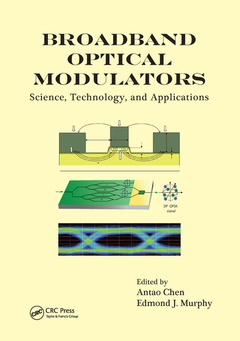Description
Broadband Optical Modulators
Science, Technology, and Applications
Coordinators: Chen Antao, Murphy Edmond
Language: English
Subjects for Broadband Optical Modulators:
Keywords
Mach Zehnder Modulator; Electroabsorption Modulators; lithium; Lithium Niobate; niobate; Electro-optic Modulator; mach-zehnder; LN Modulator; waveguides; Quadratic Eo; insertion; Optical Waveguide; loss; Half Wave Voltage; electric; Optical Pulse; eld; Traveling Wave Modulators; half; Traveling Wave Electrode; wave; Drive Voltage; Ultrashort Optical Pulses; LiNbO3 Substrate; LiNbO3 Wafer; Optical OFDM; Group Delay Dispersion; Phase Shi; Integrated Optical Circuits; Mach Zehnder Interferometer Modulator; Eo Polymer; RF Signal; Ring Resonator; Eo Material; Negative Chirp
Publication date: 06-2020
· 17.8x25.4 cm · Paperback
Publication date: 01-2012
548 p. · 17.8x25.4 cm · Hardback
Description
/li>Contents
/li>Readership
/li>Biography
/li>
"?provides the full, exciting story of optical modulators. ? a comprehensive review, from the fundamental science to the material and processing technology to the optimized device design to the multitude of applications for which broadband optical modulators bring great value. ? Especially valuable in my view is that the authors are internationally known researchers, developers, and systems people who are experts in their field, writing now, with the perspective that time offers, about their groundbreaking work. "
?Dr. Rodney C. Alferness, Senior Vice President of Optical Networking Research at Lucent Technologies? Bell Labs
Considered the most comprehensive book yet published on this critical subject, Broadband Optical Modulators: Science, Technology, and Applications offers an incredibly wide-ranging yet in-depth overview of the state of the art in the design and use of optical modulators. A compilation of expert insights, this book covers fundamental and practical aspects, from materials to systems, addressing historical and more recent developments.
Coverage includes:
- Optical and electro-optic properties of traditional single crystalline lithium niobate, silicon, and III-V compound semiconductors, as well as emerging electro-optic polymers and organic nonlinear optic crystals
- Discussion of factors important to modulator design, fabrication, and performance
- Fundamental topics, such as electro-optic effect in nonlinear optic crystals and semiconductors
Leaders in the field created this invaluable reference for scientific researchers involved in high-speed device research and development, especially in the areas of optical transmitters and optical modulators for fiber-optics communication systems. Helping readers master optical modulation techniques, this book will be invaluable to engineers (system/subsystem designers, product developers, and technical and project managers) and other professionals in the telecommunications and defense industries. It offers the audience?which includes graduate students?an in-depth understanding of the new modulator architectures and technologies now available, as well as the strengths, weaknesses, advantages, and trade-offs associated with each.
Section I: Fundamentals
Role and Evolution of Modulators in Optical Fiber Communication. Evolution of Digital Optical Modulation Formats. Fiber-Optic Analog Radio Frequency Links. Overview of Optical Modulators and the Properties That Affect Transmission System Performance.
Section II: Modulator Technology
Electroabsorption Modulators. Lithium Niobate Modulators. Indium Phosphide-Based Electro-Optic Modulators.
Section III: Emerging Technologies
Gallium Arsenide Modulator Technology. Electro-Optic Polymer Modulators. Silicon High-Speed Modulators. Organic Electro-Optic Crystal Modulators. Complex Oxide Electro- Optic Modulators.
Section IV: Practical Issues in Modulator Operation
Modulator Drivers. Reliability of Lithium Niobate Modulators. Bias Control Techniques.
Section V: Applications Beyond the Digital Telecom System
Broadband Electric Field Sensors. Passive Millimeter-Wave Imaging Using Optical Modulators. Optical Beam Forming for Microwave and Millimeter Waves. Electro-Optic Time Lenses for Shaping and Imaging Optical Waveforms. RF Photonics-Optical Pulse Synthesizer. Optoelectronic Oscillator. Electro-Optic Analog-to-Digital Converters. Fiber-Optic Gyroscopes. Polarization Control.
Antao Chen is a research professor in the physics department at the University of South Florida. He also has joint appointments as senior scientist at the Applied Physics Laboratory and associate professor at Department of Electrical Engineering, University of Washington. He received his BS and MEng degrees from Beijing Institute of Technology, Beijing, China, in 1983 and 1989, respectively, and his MS and Ph.D degrees from the University of Southern California, Los Angeles, in 1995 and 1998, respectively. He has worked in both the optical industry and academia since 1983.
Edmond J. Murphy currently works for JDSU’s Communication and Commercial Optical Products Division where he focuses on Advanced Technology Planning and Intellectual Property matters. He has been with JDSU since 1999, previously serving in various roles such as Vice President of Development, Electro-optic Products Division; General Manager, Electro-Optic Products Division; and Group Chief Technology Officer, Components and Modules Division.
These books may interest you

High-Speed Photonic Devices 74.82 €



